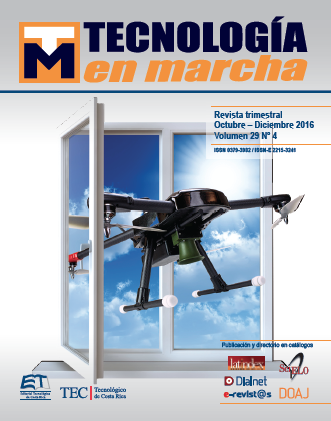Current situation of construction materials management in Costa Rica
Main Article Content
Abstract
Wildfires are uncontrolled fires spreading freely in the forest. The work for the management and control of forest fire include detection as a first step. The importance of achieving early detection of forest fires (FFED) yields in the cost reduction. The FFED is designed to give the alarm when the fire starts, using sensors for variables indicating the existence of fire, for instance, smoke (chemical variables emissions, CO, CO2, CH4) and physical variables (infrared radiation and hot).
The characteristics of the sensors used are crucial to discover the onset of fire in real time, to improve scalability, reduce the cost of the sensor network, achieving early fire detection. Sensors for infrared and thermal emissions (physical variable) are highly sensitive to facilitate detection from distance, but when used on land the disadvantage is that the foliage and terrain obstacles attenuate and scatter the infrared emission and requires towers to improve visibility.
Sensors for chemical emissions have advantages for terrestrial onset of fire detection (emissions from forest fire spread through the air and can reach the corners of the forest), they do not need line of sight nor to be placed as large height. The market also offers solutions for fire detection that could be adapted for use within the forest (eg sensors with high sensitivity and variable cost), optical detection systems for smoke and multi systems that reduce false alarms. The disadvantages; of those sensors is that they require heating energy (to raise the temperature and to detect CO or CO2 gas) and can be damaged by exceeding the limit values (gas concentration or relative humidity). Moreover, the concentration of smoke and gas near the point of detection is diminished due to the dispersion in the forest (this affects the performance of the sensors that require minimal ppm or% obscuration)
Emissions or chemical variables (CO, smoke and CO2) are detected primarily through two strategies:
-The response of these variables to physical phenomena (IR absorption, scattering IR, ionization, photoacoustic effects)
-The interaction of these variables with the sensor material used (absorption, chemical reaction or a combination of both).
Article Details
Los autores conservan los derechos de autor y ceden a la revista el derecho de la primera publicación y pueda editarlo, reproducirlo, distribuirlo, exhibirlo y comunicarlo en el país y en el extranjero mediante medios impresos y electrónicos. Asimismo, asumen el compromiso sobre cualquier litigio o reclamación relacionada con derechos de propiedad intelectual, exonerando de responsabilidad a la Editorial Tecnológica de Costa Rica. Además, se establece que los autores pueden realizar otros acuerdos contractuales independientes y adicionales para la distribución no exclusiva de la versión del artículo publicado en esta revista (p. ej., incluirlo en un repositorio institucional o publicarlo en un libro) siempre que indiquen claramente que el trabajo se publicó por primera vez en esta revista.

